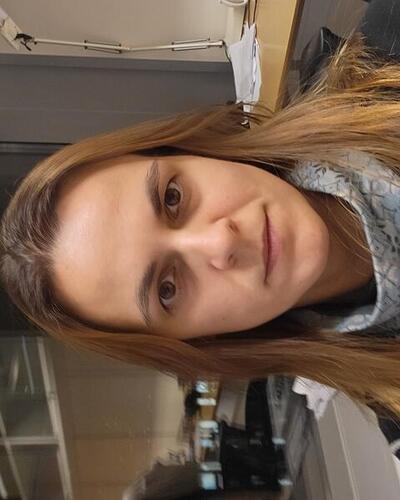- E-mailjanka.babickova@uib.no
- Visitor AddressHaukeland universitetssykehus, Laboratoriebygget5009 Bergen
- Postal AddressPostboks 78045020 Bergen
- (2023). Proteomic analysis unveils Gb3-independent alterations and mitochondrial dysfunction in a gla <sup> −/−</sup> zebrafish model of Fabry disease. Journal of Translational Medicine.
- (2023). Glomerular transcriptomics predicts long term outcome and identifies therapeutic strategies for patients with assumed benign IgA nephropathy. Kidney International. 717-730.
- (2023). Glomerular proteomic profiling reveals early differences between preexisting and de novo type 2 diabetes in human renal allografts. BMC Nephrology. 15 pages.
- (2022). Six-week inhalation of lead oxide nanoparticles in mice affects antioxidant defense, immune response, kidneys, intestine and bones. Environmental Science: Nano. 751-766.
- (2022). Reduced α-galactosidase A activity in zebrafish (Danio rerio) mirrors distinct features of Fabry nephropathy phenotype. Molecular Genetics and Metabolism Reports. 1-11.
- (2022). Gene Expression Analysis in gla-Mutant Zebrafish Reveals Enhanced Ca<sup>2+</sup> Signaling Similar to Fabry Disease. International Journal of Molecular Sciences.
- (2022). Extracellular DNA concentrations in various aetiologies of acute kidney injury. Scientific Reports. 11 pages.
- (2022). Dynamics of Plasma and Urinary Extracellular DNA in Acute Kidney Injury. International Journal of Molecular Sciences. 1-8.
- (2021). Ultrasound and Microbubbles Enhance Uptake of Doxorubicin in Murine Kidneys. Pharmaceutics.
- (2021). The Effect of Melatonin on Periodontitis . International Journal of Molecular Sciences. 1-11.
- (2021). Axl-inhibitor bemcentinib alleviates mitochondrial dysfunction in the unilateral ureter obstruction murine model. Journal of Cellular and Molecular Medicine. 7407-7417.
- (2020). Plasma Concentrations of Extracellular DNA in Acute Kidney Injury. Diagnostics (Basel). 1-12.
- (2020). Nuclear and Mitochondrial Circulating Cell-Free DNA Is Increased in Patients With Inflammatory Bowel Disease in Clinical Remission. Frontiers in medicine. 1-8.
- (2020). A collagen-binding protein enables molecular imaging of kidney fibrosis in vivo. Kidney International. 609-614.
- (2019). Six-week inhalation of CdO nanoparticles in mice: The effects on immune response, oxidative stress, antioxidative defense, fibrotic response, and bones. Food and Chemical Toxicology (FCT).
- (2019). Oxidative Stress in Animal Models of Acute and Chronic Renal Failure. Disease Markers. 1-11.
- (2019). AXL targeting reduces fibrosis development in experimental unilateral ureteral obstruction. Physiological Reports. 1-20.
- (2018). Extracellular DNA as a prognostic and therapeutic target in mouse colitis under DNase I treatment. Folia biologica (Praha). 10-15.
- (2018). Fabry nephropathy: Transcriptome sequencing of microdissected renal compartments from archival kidney biopsies at baseline, and after 5 & 10 years of enzyme replacement therapy.
- (2024). Adverse effects of acute tubular injury on the glomerulus: contributing factors and mechanisms. Pediatric nephrology (Berlin, West).
- (2020). Oxidative stress in the pathophysiology of kidney disease: Implications for noninvasive monitoring and identification of biomarkers. Oxidative Medicine and Cellular Longevity. 1-11.
- (2018). Cell-free nucleic acids in urine as potential biomarkers of kidney disease. Journal of Applied Biomedicine. 157-164.
- (2018). Cell-free DNA: the role in pathophysiology and as a biomarker in kidney diseases. Expert Reviews in Molecular Medicine. 1-14.
More information in national current research information system (CRIStin)
European Union’s Horizon 2020 research and innovation programme under the Marie Skłodowska-Curie grant agreement (No. 842619-DIE_CKD).
About the project:
Chronic kidney disease (CKD) is a major cause of morbidity and mortality, affecting over 10 % of the adult population. Regardless of the primary case, the progressed stage is characterized by scarring of all anatomical elements of the kidney - glomeruli, tubulointerstitium, and vasculature referred to as renal fibrosis. Tubulointerstitial fibrosis has largely been viewed as a consequence of glomerular scarring, reflecting hypoxia downstream from the scarred glomeruli. Novel data suggest that ongoing communication between the glomerular and tubular compartments (tubuloglomerular feedback) plays an important role in the progression of renal fibrosis. Particularly, injury to the tubular compartments leads to more pronounced glomerular injury in the future. DIE_CKD is designed to uncover the range and mechanisms of tubular injuries involved in the pathogenic tubuloglomerular feedback. To achieve the project objectives, double/quadruple transgenic mice with the possibility of time-dependent, subsequent injury to different compartments of the kidney will be used. This unique approach will enable a direct study of how the injury to tubular compartments predisposes glomeruli to more severe injury. Detailed analysis of the mechanisms behind these effects will be performed. The experimental data will be further confirmed in human renal biopsies of patients with Fabry disease with progressed CKD and renal fibrosis. A comprehensive histopathological assessment of long-term prognosis of sequential biopsies will be performed to analyze the involvement of individual compartments over time.
Publications:
https://www.asn-online.org/education/kidneyweek/2021/program-abstract.as...
https://www.asn-online.org/education/kidneyweek/2020/program-abstract.as...
https://pubmed.ncbi.nlm.nih.gov/36207374/
https://pubmed.ncbi.nlm.nih.gov/35328821/
https://pubmed.ncbi.nlm.nih.gov/32082479/
https://pubmed.ncbi.nlm.nih.gov/32168933
https://pubmed.ncbi.nlm.nih.gov/36613802/
Dissemination:
https://cordis.europa.eu/article/id/442761-molecular-breakthrough-gives-...
